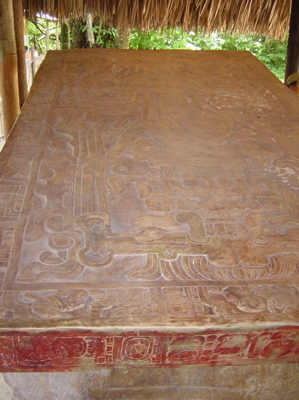![]()
I’ve given you my versions of perhaps the two most iconic structures at Palenque. This is the Templo de los Inscripciones (Temple of the Inscriptions), named for the panels of hieroglyphs on the walls of the inner sanctum of the temple on the top of the pyramid.  Today, you must have special permission to climb the steps and enter the Templo; we enjoyed it from the plaza. The panels record the accessions of kings, details of ritual ceremonies, and notable dates. Mexican archaeologist Alberto Ruz discovered a filled passageway below the floor of the rear chamber; it lead down below ground level to a small platform with a stone box atop it, that held the remains of five or six dismembered sacrificed humans. Ruz discovered an adjacent room that held the sarcophagus of Pakal, who took the throne of Palenque in the summer of AD 615, if the epigraphers are correct.
Today, you must have special permission to climb the steps and enter the Templo; we enjoyed it from the plaza. The panels record the accessions of kings, details of ritual ceremonies, and notable dates. Mexican archaeologist Alberto Ruz discovered a filled passageway below the floor of the rear chamber; it lead down below ground level to a small platform with a stone box atop it, that held the remains of five or six dismembered sacrificed humans. Ruz discovered an adjacent room that held the sarcophagus of Pakal, who took the throne of Palenque in the summer of AD 615, if the epigraphers are correct.
You can see a replica of the lid of the sarcophagus by the entrance to Palenque. The central image is of the World Tree holding Pakal as he travels down the Tree, analogous to the Milky Way, on his way to the Otherworld. Images in the borders on the top and sides tell of Pakal’s sacredness, his regal history, and name the builders and overseers of his tomb’s construction.
With this much interpretable imagery, you can tell why this lid is so important even today.

The ancient Maya, like the rest of us, located their most important places deep within their architecture.* This plaza is entirely enclosed in a complex of buildings today called the palace, which is probably an apt term. A tower overlooks this architectural complex, with views across various plazas. If Palenque had few canopy trees, this tower would have been visible across much of the residential area, too, and vice versa. If it were this tall. As I understand it, the upper tiers were reconstructed without much in the way of architectural clues, other than a considerable rubble pile.
* Just think about the layout of US McMansions, in which you must traverse several rooms from the front door, including perhaps a staircase, to enter the master suite, which serves to control entry to the innermost sanctum, the toilet room off its bathroom.